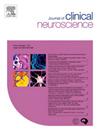丘脑下深部脑刺激对帕金森病运动症状波动的微损伤和刺激作用
IF 1.8
4区 医学
Q3 CLINICAL NEUROLOGY
引用次数: 0
摘要
目的本研究旨在探讨帕金森病(PD)颅底深部脑刺激(STN-DBS)术后短期内与微损伤效应(MLE)和刺激相关的运动症状波动。材料与方法本研究共纳入54例行双侧STN-DBS手术的PD患者。术前、术后1周和术后1个月分别评估总运动症状。对这些评分进行分析,以评估由于微损伤和刺激效应引起的运动症状波动,以及相关因素。结果48例患者(88.89%)术后1周运动症状改善,平均改善45.92%。术后1个月,27例患者(50.00%)表现出mle相关的运动症状改善,平均改善27.08%。多元线性回归分析显示,术前震颤亚评分与1周和1个月的MLE呈正相关,而术前帕金森病睡眠量表(PDSS)评分与1周的MLE呈正相关。刺激效果,在术后一个月刺激器激活后测量,导致整体运动症状改善35.21%。在一周或一个月内,有和没有MLE的患者在刺激诱导的改善方面没有观察到显著差异。结论本病例系列表明,PD患者行STN-DBS手术后1个月的刺激效果与术后MLE无关。然而,术前震颤症状更严重的患者在术后一周和一个月均表现出更大的MLE。本文章由计算机程序翻译,如有差异,请以英文原文为准。
Microlesion and stimulation effects on motor symptom fluctuations in Parkinson’s disease following subthalamic deep brain stimulation
Objectives
This study aims to investigate motor symptom fluctuations associated with microlesion effects (MLE) and stimulation in the short term following subthalamic deep brain stimulation (STN-DBS) surgery for Parkinson’s disease (PD).
Materials and Methods
A total of 54 PD patients who underwent bilateral STN-DBS surgery were included in this study. Total motor symptoms were evaluated preoperatively, one week postoperatively, and one month postoperatively. These scores were analyzed to evaluate motor symptom fluctuations due to microlesion and stimulation effects, along with associated factors.
Results
Among the participants, 48 patients (88.89%) exhibited MLE-related improvements in motor symptoms one week after surgery, with an average symptom improvement of 45.92%. At one month post-surgery, 27 patients (50.00%) demonstrated MLE-related improvements in motor symptoms, with an average improvement of 27.08%. Multivariate linear regression analysis revealed that preoperative tremor subscores were positively correlated with MLE at both one week and one month, while the preoperative Parkinson’s Disease Sleep Scale (PDSS) score was positively correlated with MLE at one week. Stimulation effects, measured one month postoperatively with the stimulator activated, resulted in an overall motor symptom improvement of 35.21%. No significant differences were observed in stimulation-induced improvements between patients with and without MLE at one week or one month.
Conclusions
This case series demonstrated that the efficacy of stimulation one month postoperatively was not correlated with postoperative MLE in PD patients who underwent STN-DBS surgery. However, patients with more severe preoperative tremor symptoms exhibited greater MLE at both one week and one month postoperatively.
求助全文
通过发布文献求助,成功后即可免费获取论文全文。
去求助
来源期刊

Journal of Clinical Neuroscience
医学-临床神经学
CiteScore
4.50
自引率
0.00%
发文量
402
审稿时长
40 days
期刊介绍:
This International journal, Journal of Clinical Neuroscience, publishes articles on clinical neurosurgery and neurology and the related neurosciences such as neuro-pathology, neuro-radiology, neuro-ophthalmology and neuro-physiology.
The journal has a broad International perspective, and emphasises the advances occurring in Asia, the Pacific Rim region, Europe and North America. The Journal acts as a focus for publication of major clinical and laboratory research, as well as publishing solicited manuscripts on specific subjects from experts, case reports and other information of interest to clinicians working in the clinical neurosciences.
 求助内容:
求助内容: 应助结果提醒方式:
应助结果提醒方式:


